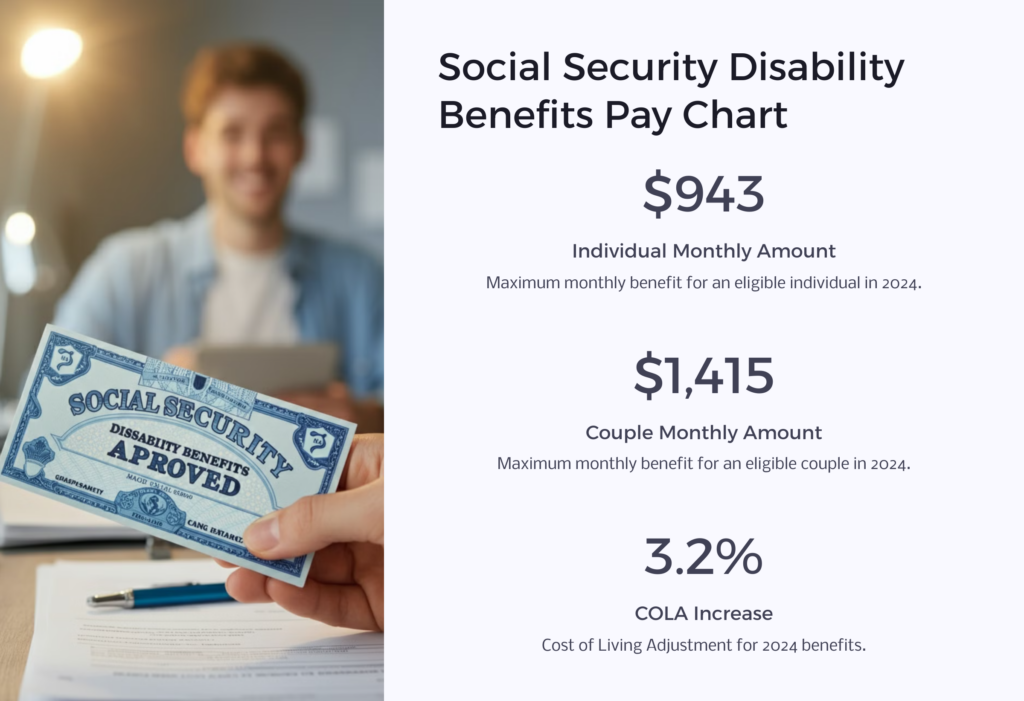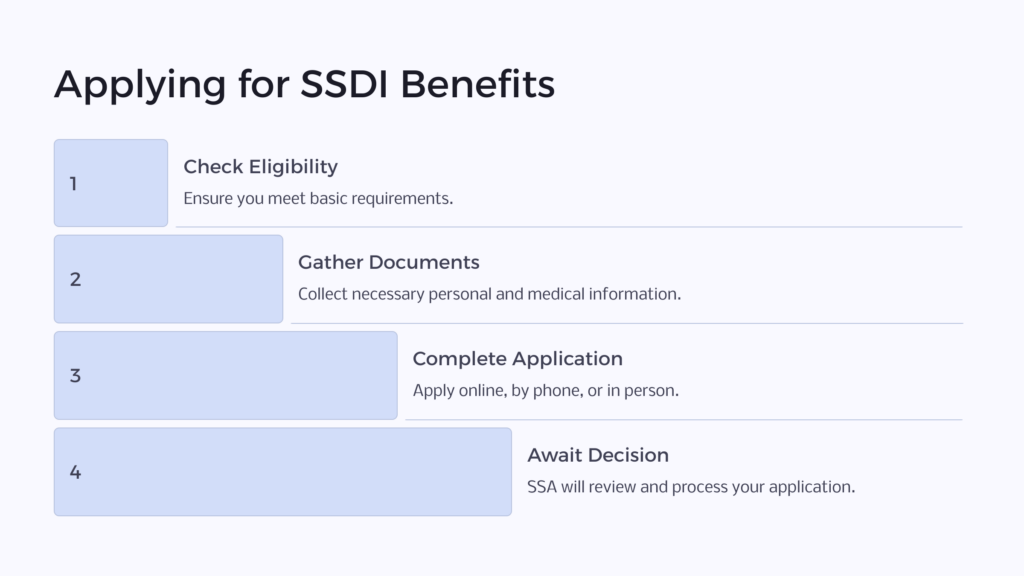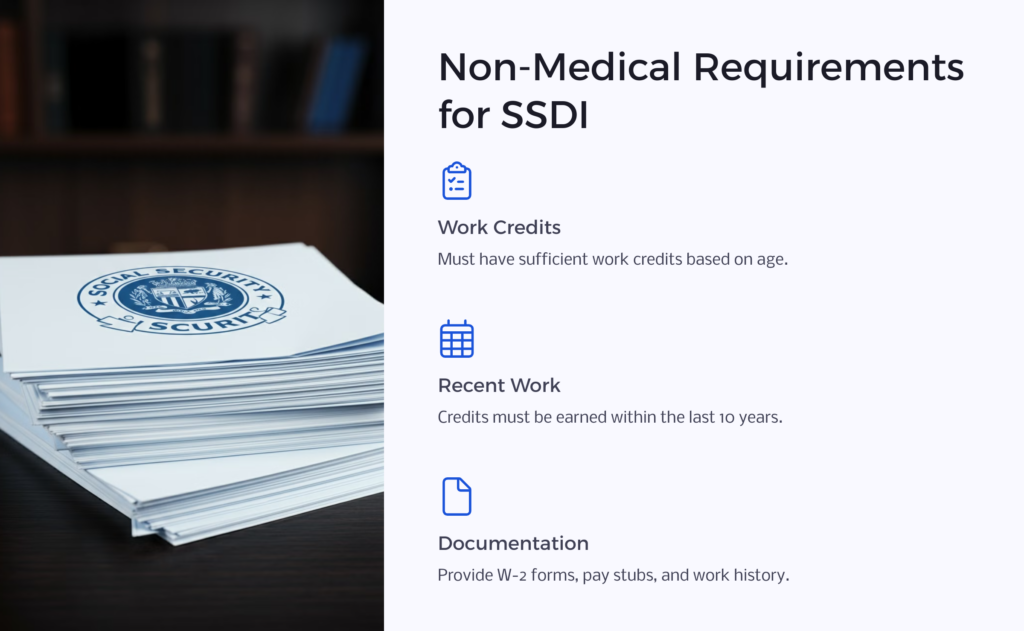Understanding what a Social Security disability benefits pay chart is will help you figure out what to expect with each payment. This benefits chart applies to the SSI benefit program only. It doesn’t cover the Social Security disability benefits you might receive through the Social Security Disability Insurance program.
When you’re getting ready to apply for Social Security payments, you want an accurate Social Security disability benefits pay chart to help guide you. So let’s look at this type of pay chart and answer some of the most important questions about Social Security and Social Security Disability.
What is a Social Security Pay Chart?

When you receive benefits from the SSI program, you will have a Social Security pay chart to show you how much you will receive with each payment. Your pay chart will be different from someone else’s. It will typically vary year to year, as well. The Cost of Living Increase (COLA) for 2024 raised the amount you can receive by 3.2%.
| Recipient | 2023 Annual Amount | 2024 Annual Amount | 2024 Monthly Amount |
| Eligible individual | $10,970.44 | $11,321.49 | $943 |
| Eligible couple | $16,453.84 | $16,980.36 | $1,415 |
| Essential person | $5,497.80 | $5,673.73 | $472 |
The most important thing to understand about your Social Security pay chart is the information it will provide you. You will know the monthly benefit amounts to expect when you have an accurate chart.
How Much Disability Pay Will I Receive This Year?
There is one main factor that is used to help determine the amount of your SSDI payment each month. This is because Social Security Disability offers a monthly benefit for those who qualify. It’s not a flat amount set for everybody that qualified, however. Instead, the amount can vary depending on one main factor.
What Factors Determine My Payment Amounts?
The main factor in figuring out your SSDI benefit is your average lifetime earnings before you became disabled. While you might think the severity of your disability is a factor, it’s not. However, the severity of your disability might be a factor used to figure out other types of payments from other sources.
SSDI is used to help workers who can no longer work due to a disability. It’s not the same as Supplemental Security Income, which will pay disability benefits based on limited resources and income. To qualify for SSDI payments, you must have worked for a certain amount of time and paid Social Security tax (FICA).
While there is only one main factor used to determine the benefit you can receive from SSDI, there are some other payments you may receive that can impact your disability benefits. For example, if you already receive other government benefits, including public disability benefits, pensions, or workers’ compensation, these may impact your disability benefits. Therefore, it’s important to understand how these types of payments might impact your disability compensation.
The Average SSDI Payment in The Last Five Years
Over the past five years, the average SSDI benefit payment has ranged from $800 to $1,800. The average for 2024 is about $1,537, and this amount can certainly change every year. These payments come primarily from the Social Security tax paid by workers. About 8.2 million people receive disabled worker benefits from Social Security, according to a Chart Book SSDI article.
While it can help to understand the average payment for disability insurance, it won’t determine your benefit. Benefit amounts can vary quite a bit based on what you qualify for.
How Does Social Security Calculate Disability Payments?

Your disability payment will be calculated in the same way as your Social Security benefit. Both are based on the record of “covered earnings” from the time you spent working and paying the FICA tax.
The calculation from the Social Security Administration (SSA) will start with the average monthly income you earned throughout your working life. Then, they will use an adjustment for historical wage growth and plug that figure into a formula, which will give you your primary insurance amount (PIA), which is also called your full retirement benefit.
The PIA formula is progressive, providing a higher benefit for lower earners. This works the same if you’re applying for disability payments or retirement payments. The difference between the two types of payments comes in when it comes to determining the full benefit.
When you apply for retirement benefits through the Social Security Administration, they use the 35 highest-earning years to calculate your monthly average income and PIA. However, since you might become a disabled worker before reaching the full retirement age, a different timeframe is used to figure out disability insurance benefits.
The number of years used to figure out the benefit will depend on how old you were when you became unable to work. The SSA will count the years from when you turned 22 to the age you became disabled. The formula will fluctuate between one and five years, depending on how long you worked. These years are known as dropout years. This will provide the number of years that will be used to figure out your PIA, which is known as elapsed years and computation years.
It doesn’t matter how old you are when you become disabled; you will receive 100% of your PIA when your SSDI claim is approved. However, this full payment is often lower for an SSDI recipient compared to a retiree. This is partially because becoming disabled can cost you some of your highest-earning years, which could have boosted your payment.
Along with the basic way SSDI payments are calculated, your disability compensation can be impacted, if you’re receiving other government benefits, such as state disability benefits, workers’ compensation, or public disability payments. However, your disability payment will not be reduced by any private disability benefits you receive.
When Are Payments Sent Out?
Payment dates for SSDI and SSI depend on which benefit you are getting and your birthday. These dates have stayed the same since 1997, but they could change in the future. For now, you can expect the following dates for your Social Security disability insurance payments if you started receiving these benefits after 1997:
- Birth dates between the 1st and 10th of the month – Social Security Disability payments are sent out by check or direct deposit on the second Wednesday of every month.
- Birth dates between the 11th and 20th of the month – Social Security Disability payments are sent out by check or direct deposit on the third Wednesday of every month.
- Birth dates between the 21st and 31st of the month – Social Security Disability payments are sent out by check or direct deposit on the fourth Wednesday of every month.
Keep in mind that if you’re receiving benefits based on your spouse’s work record or a parent’s work record, the payment date will be based on the spouse’s or parent’s birth date, not your birth date.
Social Security also urges all SSDI recipients to sign up to receive direct deposit through the Direct Express car program or an Electronic Transfer Account. While you don’t have to use direct deposit, it’s highly recommended.
If you also receive an SSI benefit, that payment schedule will differ from the SSDI payment schedule. SSI benefits are a bit easier to predict as they are paid on the first day of every month. However, the benefits will arrive on the next banking day if the first day of the month is a Saturday, Sunday, or legal holiday.
There is one exception to this rule, however. Since January 1st is a yearly holiday, the SSI payments will go out on the last day of December, which isn’t a holiday, Saturday, or Sunday. SSI recipients must use direct deposit through the Direct Express card program or an Electronic Transfer Account.
Understanding both the pay chart and schedule for SSI and SSDI will help you plan your budget. You want to know how much you will receive and when you will receive it so that you can pay your bills on time.
How To Properly Apply for Social Security Disability Benefits

It can be a bit confusing when you want to figure out how to file for disability. The system is not exactly the easiest to navigate, but there are some basic things you should know when applying for disability insurance benefits or disability retirement benefits.
Before applying for adult disability benefits, you should ensure you qualify. Anybody aged 18 or older can use the online application to apply for disability benefits. The basic requirements you need to meet include the following:
- You are currently not receiving any benefits on your Social Security record
- You are unable to work due to a medical condition that is expected to result in death or last for at least 12 months
- You have not been denied any disability benefits within the past 60 days
If you were recently denied for a medical reason, you will want to use the Internet Appeal to request a review instead of going through the full application process again.
As long as you meet these requirements, you can follow the necessary steps to apply for disability benefits. The steps include:
- Print out and review the Adult Disability Checklist
- Complete the Disability Benefit Application
- Complete the Medical Release Form
This is the simple process of how to apply for SSDI, but there is more to it. These three steps will require you to gather the right documents and provide the necessary information.
You will want to have all the right information ready when you apply, including:
- Where you were born and when you were born
- Your Social Security number
- The name, birth date or age, and Social Security number of your spouse and any former spouse.
- The dates and places of any marriage and the dates of any divorce or death of a spouse
- Names and birth dates for your minor children
- Your banking information for receiving your benefits, if you want to use direct deposit
- Information about your medical condition, including the name, address, and phone number of someone who can be contacted about your medical conditions
- Detailed information about your illness, condition, or injury
- Medicines you are taking and who prescribed them to you
- Information about any medical tests you have gone through
- Documentation showing your income earnings for last year and this year
- The name and address of your employer for last year and this year
- A copy of your Social Security Statement
- The beginning and end dates for any time you spent in the U.S. Military before 1968
- A list of jobs you had in the past 15 years, up to 5 jobs, before you became disabled
- Information about workers’ compensation you might be getting or other benefits you have filed for
This is quite a bit of information to gather. Some of the documents you will want to have handy while applying for SSDI benefits include the following:
- A birth certificate
- Proof of U.S. citizenship or lawful alien status
- U.S. Military discharge papers
- W-2 forms or self-employment tax returns
- Medical evidence, including medical records, recent test results, and doctors’ reports
- Award letters, settlement agreements, pay stubs, and other proof of income or benefits you are receiving
You may need to mail some of these documents to the SSA when you apply for SSDI benefits.
You can apply for SSDI with the online disability application process, which makes it a bit easier. This system allows you to start your claim immediately and fill out the application from home. You will also be able to stop and return to where you left off as you gather information and fill out the application.
It’s also possible to apply over the phone or in person at a local Social Security office.
What Can I Expect After Application?
Once your application has been received, you will be given confirmation through mail or electronically. Your application will be reviewed, and you may be contacted if more information or documentation is needed.
The SSA will also inform you if anybody else in your family can receive benefits on your record or if you can receive benefits on another person’s record, such as a parent or spouse. Your application will be processed once all the information and documentation have been received. Then, a final decision will be mailed to you.
What Are the Non-Medical Requirements for SSDI?

While it’s rather obvious that you need to meet the medical requirements to receive SSDI benefits, you also need to meet the non-medical requirements. These requirements include a review of your employment history. You must have the necessary work credit status with the SSA to qualify for benefits.
Work credit status requires that you have contributed to the Social Security fund through a payroll deduction from paychecks for your earnings during the ten years before you became disabled. This will be a part of the review from the SSA when you apply for SSDI benefits.
When you need to meet the non-medical requirements for SSDI, you will also need to have earned enough work credits. The number of work credits you will need depends on your age:
- Under 24 years of age – You will need to have worked for at least 1.5 years and earned six or more work credits.
- 24 to 30 years of age – You will need to have worked for 2 to 4.5 years and earned 8 to 18 work credits.
- 31 to 42 years of age – You will need to have worked for five years and earned 8 to 20 work credits.
- 42 years of age and up – After the age of 42, th
- necessary work credits will go up by two every two years. This means if you’re 44 years of age, you will need 22 work credits; if you’re 46 years old, you will need 24 work credits, and so on.
You will submit copies of your W-2 forms, pay stubs, taxes, and work history to prove you have enough work credits to qualify for SSDI.
While this can all seem rather daunting, if you have worked recently and become disabled, you will likely qualify for SSDI from the SSA. Even if you don’t qualify for SSDI, there are other benefits you may be able to receive.
What If I Need More Work Credits?
If you are short on work credits for SSDI, you may qualify for SSI, which is available for those with extreme financial needs. The requirements for SSI are quite different and include the following:
- If you are single with less than $2,000 in income and assets.
- If you are married and the combined income and assets with your spouse are less than $3,000
Land, cash, investments, vehicles, personal property, and a few other assets will be used in the qualifications for SSI.
At What Age Can You Access Social Security?
If you are applying for Social Security retirement benefits, you can apply as early as age 62. However, you will only get your full benefits once you reach your full retirement age. If you take benefits early, your full retirement age can be as high as 70.
Applying for SSDI is much different. You can apply for this benefit from the SSA at age 18. There are different categories for the age when applying for SSDI, which include:
- 18 to 49 years of age – Those in this category are considered young individuals.
- 50 to 54 years of age – Those in this category are considered to be close to approaching advanced age.
- 55 to 59 years of age – Those in this category are considered to be advanced age.
- 60 to 65 years of age – Those in this category are considered to be approaching retirement age
Age can have an impact on SSDI. For example, those 55 and older may have a higher chance of being approved for SSDI benefits due to the limits to the type of work they might be able to do compared to someone under the age of 49.
While you can apply for SSDI at age 18 or older, those 18 years of age can only get disability based on their parent’s earning record. This is known as a Childhood Disability Beneficiary (CDB), which may be given to someone who is at least 18 years of age and became disabled before the age of 22, as long as they have a parent who worked and paid Social Security taxes that is now retired, deceased or disabled.
There is also a Disabled Widows/Widowers Benefit (DWB) that may be paid to those 50 years of age or older with a deceased spouse who paid Social Security taxes.
At What Age Does Social Security End?
The age at which Social Security starts and ends will depend on the benefit. While Social Security retirement benefits start as early as age 62 and are paid for life, some Social Security benefits are not paid similarly.
If you receive Social Security spousal benefits, you will also get payments for life. However, the duration of Social Security survivor benefits for deceased workers will vary for certain family members. The duration of SSDI benefits will also vary.
With SSDI benefits, the benefit will often be for life unless the SSA determines you no longer qualify. In some circumstances, your disability may heal enough that you can return to work. The SSA requires a severe disability, defined as a disability expected to last at least one year or result in death, to qualify for SSDI.
Those receiving Social Security Disability Spousal benefits will end at the death of the disabled worker or the death of the spouse. The SSA can also determine that the individual no longer qualifies, which will end the benefit.
When Can I Access My Benefits?
Social Security retirement benefits can be accessed at age 62, but you may decide to wait until your full retirement age. If you are applying for SSDI benefits, you can start receiving this benefit six full months after the onset of the disability. Other benefits from the SSA may vary on when you can gain access.
 Benefits.com Advisors
Benefits.com Advisors
With expertise spanning local, state, and federal benefit programs, our team is dedicated to guiding individuals towards the perfect program tailored to their unique circumstances.
Rise to the top with Peak Benefits!
Join our Peak Benefits Newsletter for the latest news, resources, and offers on all things government benefits.



















